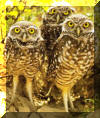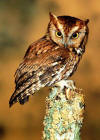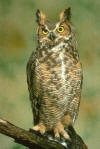Discover Florida Nature
It's time to explore the natural Florida


|
|
|
|
|
 Burrowing
Owl- The burrowing owl is a pint-sized bird that lives in open,
treeless areas. The burrowing owl spends most of its time on the ground,
where its sandy brown plumage provides camouflage from potential
predators. One of Florida's smallest owls, it averages nine inches in
height with a wingspan of 21 inches. The burrowing owl lacks the ear
tufts of the more familiar woodland owls. Bright yellow eyes and a white
chin accent the face. Unusually long legs provide additional height for
a better view from its typical ground-level perch. The Florida burrowing
owl occurs throughout the state although its distribution is considered
local and spotty. Burrowing owls inhabit open native prairies and
cleared areas that offer short groundcover including pastures,
agricultural fields, golf courses, airports, and vacant lots in
residential areas. Burrowing owls live as single breeding pairs or in
loose colonies consisting of two or more families. Unlike most owls,
burrowing owls are active during both day and night. During the day,
they are usually seen standing erect at the mouth of the burrow or on a
nearby post. When disturbed, the owl bobs in agitation and utters a
chattering or clucking call. In flight, burrowing owls typically
undulate as if they are flying an invisible obstacle course. They also
can hover in midair, a technique effective for capturing food. Burrowing
owls mainly eat insects, especially grasshoppers and beetles. Burrowing
Owl- The burrowing owl is a pint-sized bird that lives in open,
treeless areas. The burrowing owl spends most of its time on the ground,
where its sandy brown plumage provides camouflage from potential
predators. One of Florida's smallest owls, it averages nine inches in
height with a wingspan of 21 inches. The burrowing owl lacks the ear
tufts of the more familiar woodland owls. Bright yellow eyes and a white
chin accent the face. Unusually long legs provide additional height for
a better view from its typical ground-level perch. The Florida burrowing
owl occurs throughout the state although its distribution is considered
local and spotty. Burrowing owls inhabit open native prairies and
cleared areas that offer short groundcover including pastures,
agricultural fields, golf courses, airports, and vacant lots in
residential areas. Burrowing owls live as single breeding pairs or in
loose colonies consisting of two or more families. Unlike most owls,
burrowing owls are active during both day and night. During the day,
they are usually seen standing erect at the mouth of the burrow or on a
nearby post. When disturbed, the owl bobs in agitation and utters a
chattering or clucking call. In flight, burrowing owls typically
undulate as if they are flying an invisible obstacle course. They also
can hover in midair, a technique effective for capturing food. Burrowing
owls mainly eat insects, especially grasshoppers and beetles.  Barn
Owl-
The barn owl (Tyto alba) is found throughout the state
of Florida and inhabits hardwood and tropical hammocks, urban areas with
abundant palms and large hardwoods, and manmade structures such as
silos, barns, and deserted buildings. Barn owls forage voraciously for
rodents in open areas such as prairies, pastures, fields, and sparsely
wooded areas. Barn owls in Florida breed from March through July and
nest in secluded places like caves, barns, tree cavities, and large bird
houses. They build no actual nest and lay from 3-11 (most commonly 5-7)
white or buff-white eggs. Many people attract barn owls by erecting nest
boxes in an effort to control local rodent populations Barn
Owl-
The barn owl (Tyto alba) is found throughout the state
of Florida and inhabits hardwood and tropical hammocks, urban areas with
abundant palms and large hardwoods, and manmade structures such as
silos, barns, and deserted buildings. Barn owls forage voraciously for
rodents in open areas such as prairies, pastures, fields, and sparsely
wooded areas. Barn owls in Florida breed from March through July and
nest in secluded places like caves, barns, tree cavities, and large bird
houses. They build no actual nest and lay from 3-11 (most commonly 5-7)
white or buff-white eggs. Many people attract barn owls by erecting nest
boxes in an effort to control local rodent populations  Common
Screech Owl- The Eastern Screech Owl is a small, nocturnal,
woodland Owl. There are two color morphs, a gray phase and a
reddish-brown phase. The Eastern Screech-Owl flies fairly rapidly with a
steady wingbeat (about 5 strokes/second). They rarely glide or hover,
but may fly with erratic movements, when maneuvering through wooded
areas. Their wings are broad and the head is held tucked in giving the
bird a stubby appearance when flying. When threatened, an Eastern
Screech Owl will stretch its body and tighten its feathers in order to
look like a branch stub to avoid detection, but will take flight when it
knows it has been detected. In open roosts, gray-phase birds
tend to roost next to a tree
trunk, whereas red-phase birds tend to roost in outer foliage, possibly
because of thermal requirements. Common
Screech Owl- The Eastern Screech Owl is a small, nocturnal,
woodland Owl. There are two color morphs, a gray phase and a
reddish-brown phase. The Eastern Screech-Owl flies fairly rapidly with a
steady wingbeat (about 5 strokes/second). They rarely glide or hover,
but may fly with erratic movements, when maneuvering through wooded
areas. Their wings are broad and the head is held tucked in giving the
bird a stubby appearance when flying. When threatened, an Eastern
Screech Owl will stretch its body and tighten its feathers in order to
look like a branch stub to avoid detection, but will take flight when it
knows it has been detected. In open roosts, gray-phase birds
tend to roost next to a tree
trunk, whereas red-phase birds tend to roost in outer foliage, possibly
because of thermal requirements.  Barred
Owl- The Barred Owl is a medium-sized gray-brown Owl streaked
with white horizontal barring on the chest and vertical barring on the
belly. They are round-headed with a whitish/brown facial disk with dark
brown trim. The eyes are brown, and the beak is yellow and almost
covered by feathers. They have a long tail. There is no difference in
plumage between males and the larger females. A very opportunistic
hunter, a Barred Owl can sometimes be seen hunting before dark. This
typically occurs during the nesting season or on dark and cloudy days. A
Barred Owl will use a perch, from where it dives upon its prey - meadow
voles are its main prey, followed by shrews and deer mice. Other mammals
include rats, squirrels, young
rabbits, bats,
moles,
opossums,
mink, and
weasels. Birds are taken occasionally, including woodpeckers, grouse,
quail, jays, blackbirds, and pigeons. They also eats small fish,
turtles, frogs, snakes, lizards, crayfish, scorpions, beetles, crickets,
and grasshoppers. Birds are taken as they settle into nocturnal roosts,
because they cannot catch birds on the wing. They will also swoop down
to the water's edge to catch frogs, other amphibians, and occasionally
fish. Barred Owls are attracted to campfires and lights where they
forage for large insects. Prey is usually devoured on the spot. Barred
Owl- The Barred Owl is a medium-sized gray-brown Owl streaked
with white horizontal barring on the chest and vertical barring on the
belly. They are round-headed with a whitish/brown facial disk with dark
brown trim. The eyes are brown, and the beak is yellow and almost
covered by feathers. They have a long tail. There is no difference in
plumage between males and the larger females. A very opportunistic
hunter, a Barred Owl can sometimes be seen hunting before dark. This
typically occurs during the nesting season or on dark and cloudy days. A
Barred Owl will use a perch, from where it dives upon its prey - meadow
voles are its main prey, followed by shrews and deer mice. Other mammals
include rats, squirrels, young
rabbits, bats,
moles,
opossums,
mink, and
weasels. Birds are taken occasionally, including woodpeckers, grouse,
quail, jays, blackbirds, and pigeons. They also eats small fish,
turtles, frogs, snakes, lizards, crayfish, scorpions, beetles, crickets,
and grasshoppers. Birds are taken as they settle into nocturnal roosts,
because they cannot catch birds on the wing. They will also swoop down
to the water's edge to catch frogs, other amphibians, and occasionally
fish. Barred Owls are attracted to campfires and lights where they
forage for large insects. Prey is usually devoured on the spot. Great
Horned Owl- The Great horned owl has a wide range and habitat,
but are always a permanent resident of their chosen territory. There are
almost no predators to the adult Great Horned Owl, however they are at
times killed in fights with eagles, snowy owls and many times other
great horns, which does end in cannibalism at times. The Great Horned
Owl will sit at night, on a high tree or perch, waiting for a prey
animal and then swoop down on it, and usually do not miss their strike.
Great horned owl prey will include rats, squirrels, mice, moles, voles,
marmots, skunks,
shrews, bats, weasels, gerbils and even porcupines. The Great Horned Owl has incredible hearing and excellent vision in very low light. Their hearing is much better so far as depth perception than that of a human.. This is possible because their ears are not placed at the same elevation on
their heads but rather are typically one, a bit higher than the other. One interesting fact about Great Horned owls is that their eyes are not movable. Rather than turning the eye in its socket the owl must turn its head instead. Great Horned Owls are some of the earliest-breeders in North America, many times
breeding in mid to late January or early February. They select their mates in
December and are often heard calling to each other. Great
Horned Owl- The Great horned owl has a wide range and habitat,
but are always a permanent resident of their chosen territory. There are
almost no predators to the adult Great Horned Owl, however they are at
times killed in fights with eagles, snowy owls and many times other
great horns, which does end in cannibalism at times. The Great Horned
Owl will sit at night, on a high tree or perch, waiting for a prey
animal and then swoop down on it, and usually do not miss their strike.
Great horned owl prey will include rats, squirrels, mice, moles, voles,
marmots, skunks,
shrews, bats, weasels, gerbils and even porcupines. The Great Horned Owl has incredible hearing and excellent vision in very low light. Their hearing is much better so far as depth perception than that of a human.. This is possible because their ears are not placed at the same elevation on
their heads but rather are typically one, a bit higher than the other. One interesting fact about Great Horned owls is that their eyes are not movable. Rather than turning the eye in its socket the owl must turn its head instead. Great Horned Owls are some of the earliest-breeders in North America, many times
breeding in mid to late January or early February. They select their mates in
December and are often heard calling to each other.
|
|
|
Advertise | Privacy Statement | Dog Encyclopedia | Video |Contact | Alaska Nature |
|